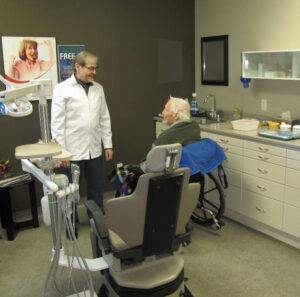Eight years ago, I moved my implant and denture clinic three blocks west on Charing Cross Street to provide services in a barrier free facility.
Although Ontario legislation does not require businesses to be barrier free until 2025 I found this unacceptable and decided to act. I purchased the building from the CAA in July 2008.
After nine months of extensive renovations, our automatic doors opened to our barrier free clinic.
Whether you arrive by way of your own vehicle, Brantford Lift or taxi you can drive right in front of the entrance. There are no ramps or stairs to navigate as the entrance is at parking lot level.
The automatic door permits the outside door and the foyer door to open on a relay system.
You are greeted with a warm welcoming smile from Teresa. Her reception desk is designed to accommodate wheelchairs, scooters or walkers. A comfortable ergonomic area is available to fill out dental/medical forms, make appointments, payments or share stories and laughs with her.
The treatment rooms are designed spaciously enough to accommodate large scooters, wheelchairs and baby buggies. The treatment rooms are also large enough to treat those who are unable to move from their wheelchairs/scooters into a dental chair for treatment. For those able to move into a dental chair the clinic is equipped with special knee-break dental chairs, which permit the patient to sit the same easy way they would in any armchair. Once seated this specially designed chair automatically lifts the legs gently into a comfortable position to support the legs, back and neck while dental procedures are performed.
Often buildings have barrier free entrances but not barrier free public washrooms. This is critical and is one room in this clinic that was specifically designed by a consultant who is in a wheelchair.
An essential service that provides dignity to the patients.
It is not just about wheelchairs, scooters, walkers and baby buggies it is also about those people who have other mobility concerns such as knee or hip replacements and who find it difficult to raise their legs on steps.
People that have diseases that play havoc on muscle control such as Parkinson’s, Multiple Sclerosis and those who have suffered from Strokes can also benefit from barrier free access.
Having doors wide enough to assist those needing an arm from a family member or my staff to steady them or for those whose eyesight is impaired and may need help getting in, is also important.
It is amazing how quickly eight years has past. It has been a positive, rewarding move to welcome familiar and new smiles of any age to our barrier free clinic.
~Nancy Tomkins~


